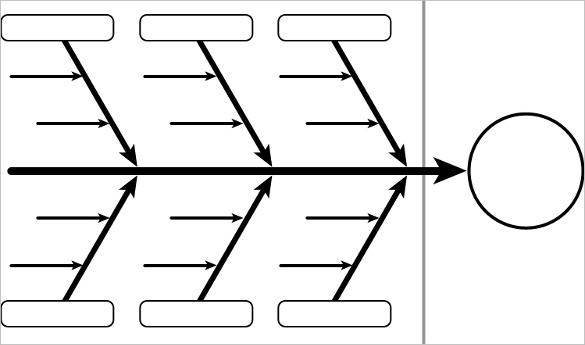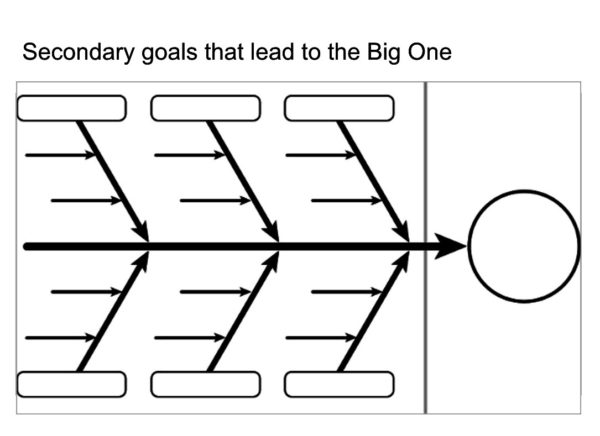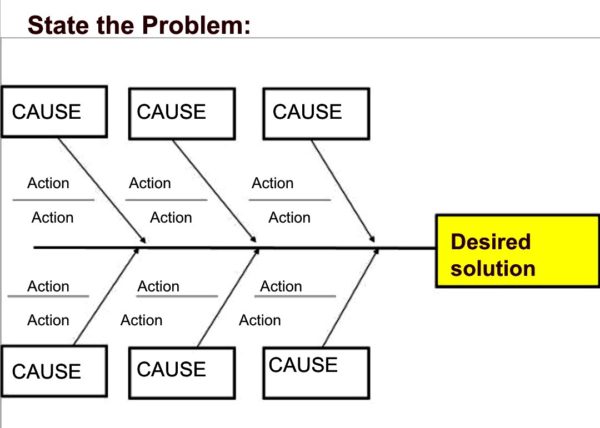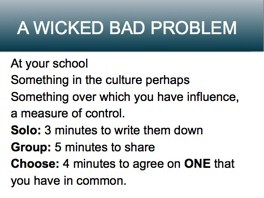When it comes to school improvement – or the fine art of problem finding and solution seeking – it’s always best to try and get everyone involved in the process. It’s a way to develop co-ownership of the culture and collectively seeking solutions that have a chance of actually being effective. As Margaret Wheatley says: “There is no problem to which community is not the answer.”
So here are a couple of techniques that can be helpful in that process of engaging minds and crowd sourcing ideas for ways forward: The Fishbone and the Five Whys. Both are helpful at looking into cause and effect and getting people working together to dig a little deeper or think more broadly.
So let’s imagine your team or the whole faculty and administration have set aside some time to look at school culture with a view to making a few changes. First get people to start naming what’s on their mind. What bugs them about the ways things are? (You might want to reserve the three big ones – compensation, stress and the problems with management (!) – for another time when you are ready to take them on. Aspects of all problems however fraught can be tackled if approached thoughtfully. But for the sake of this post we’ll stick with some safe topics. Examples might be: Students arriving late for class; behavior in the lunchroom; reports of bullying on the playground; getting parents more involved in school. The list is endless. Making progress on a few key issues can shift culture, boost morale and develop a sense of agency and capacity for change.
Have people work in small groups – three is ideal – to generate the topics. What are some of the issues about life and routines in the community really bug them. What are the problems which – if fixed or changed – would improve the quality of life in school? Maybe it’s an issue that been around for ever but just never gets fixed. Ask each group to generate a list of everything that comes to mind. Give a time limit. Say five minutes. Write them down.
Then each group looks at their list and does some prioritizing. Pick one. Their choice of the thing that they agree bugs them.

Any problem worthy of the name probably has a number of root causes. Not to mention a need to be solved with a multi-pronged approach.
The fishbone proves a visual guide to breaking it down. It gets its name from the shape of the template structure that’s used to record and shape ideas and the thinking and it can be used in a variety of ways.
Using the diagram on the left participants working in pairs, trios or small groups can enter the desired outcome in the circle

Then choose up to six potential problem causes in the oblongs.
Then on the arrows come up with and two or more action steps that would lead to dealing with that cause and lead to the desired solution.
The same procedure can be used to break down the components of a larger goal.

I’ve written about the Five Whys before and you can find it here. It’s a great technique for getting below the surface of issue.
It’s starts of course with naming what the problem or complaint.

Participants should again list some of the wicked bad problems that bedevil them and the organization. Something they would love to see fixed.
This technique is good for unearthing the bottom line and identifying possible action steps.
So what’s the problem?
- We are not fully enrolled.
- The lunchroom is too noisy and rowdy.
- Our faculty and administration are not diverse and do not reflect the diversity of our student population.
- Students are late getting to class after PE.
- Students are repeating Trump’s words to attack one another at recess.
- The playground is full of litter
- And so on through a litany of negative observations about life in school all of which can changed for the better once root causes and definitive actionable steps have been identified and taken.
Let’s take one and play it out:
Our faculty and administration are not diverse and do not reflect the diversity of our student population.
- Why? Candidates of color do not apply when we advertise openings.
- Why don’t they apply? We don’t make it clear that we value diversity.
- Why don’t we make it clear? We don’t have a diversity statement on our website.
- Why don’t we have a statement on our website? There’s no logical place to put it.
Bottom line: Create the statement and find the place for it.
This is a good activity for several groups to tackle the same issue. That way you may arrive at a number of potential workable solutions worth trying. Depending on their Why tree other groups will come up with other actionable bottom lines worth trying.
The trick is to avoid dead ends and stop when you have arrived at an actionable step – a place where you can do something to make it better.
And as soon as you have reached an actionable step you have the beginnings of a plan of action.

Featured image: Four Colour Sets Mapped Deictically Presented Twice in Logical Form Richard Bell 1981-1982


